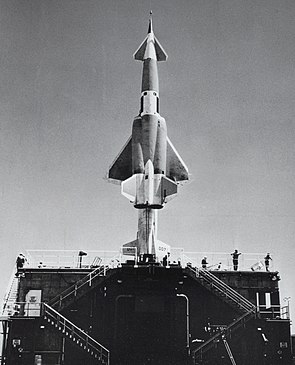SM-64 Navaho
| SM-64 Navaho | |
|---|---|
| General Information | |
| Type | Cruise missiles |
| NATO designation | SM-64 Navaho, SSM-A-2 |
| Country of origin |
|
| Manufacturer | North American Aviation |
| development | 1946 |
| Commissioning | Development stopped |
| Technical specifications | |
| length | 20.65 m |
| diameter | 1,830 mm |
| Combat weight | 27,200 kg (cruise missile) 34,000 kg (booster) |
| span | 8.71 m |
| Drive First stage Second stage |
1 booster with 1,070 kN 2 Ramjets with 36 kN |
| speed | Mach 2.75 |
| Range | 5,600 km |
| Service ceiling | 24,000 m |
| Furnishing | |
| steering | Inertial navigation platform and astronomical navigation |
| Warhead | W-39 nuclear warhead with 4.0 Mt |
| Weapon platforms | Floor-bound, start from the starting table |
| Lists on the subject | |
The North American SM-64 Navaho was an experimental, supersonic, intercontinental cruise missile built by North American Aviation . The program ran from 1950 to 1958, with a total of ten launches on Launch Complex 9 (LC-9) in Cape Canaveral Air Force Station (CCAFS) between 1956 and 1958. Launch Complex 10 (LC-10) was also assigned to the Navaho program and a Navaho took off from there in 1956. All Navahos launched were G-26 trial versions.
The Navaho consisted of two parts, a launcher with liquid fuel and the actual cruise missile, which carried the warhead and was powered by two ramjet engines. The launcher accelerated the cruise missile to almost Mach 3, igniting the ramjet engines and detonating the launcher. Successful launches have been made towards the Caribbean islands. The missile then turned around and landed on the Skid Strip of CCAFS .
The cruise missile was named after the Navajo nation and adheres to the tradition established by North American Aviation of starting projects codenamed with the letters "NA".
The program was discontinued after five failed attempts out of a total of eleven. Funders switched to more promising projects like the SM-62 Snark and the Atlas and Titan ICBMs .
A similar, but much more ambitious project was the Pluto cruise missile , which was developed from 1956 to 1964 and was intended to carry up to 24 hydrogen bombs in enemy territory with a practically unlimited range and newly developed TERCOM navigation .
Armament
Web links
- Directory of US Military Rockets and Missiles: North American SM-64 Navaho , by Andreas Parsch
